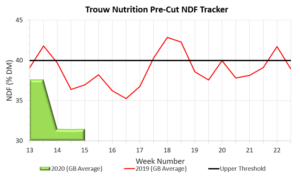This week, the lab at Trouw Nutrition GB has seen an increase in the number of milk yield from grazing (MYFG) samples. It is still important to highlight that while differences year on year may seem significant it still remains difficult to draw conclusions from a limited data set.
Grass growth across the UK has continued to increase, averaging 27kg DM/ha/day, up 5kg DM/ha/day since last week. Region variation is large, with the North East seeing the highest grass growth rates of 38kg DM/ha/day, and Yorkshire has seen a 4kg DM/ha/day decrease in grass growth compared to last week’s figures. While remaining regions have seen a consistent increase.
A large range in potential MYFG can be seen this week, ranging from M+1.1litres/day in the Wales and West up to M+13.1 litres/day in Scotland. Unfortunately, no samples were received from the North East and Yorkshire, so values are unavailable for these regions. Across the samples submitted, compared to last week, the average MYFG has risen significantly; averaging M+8.45 litres/day. This is due to an increase in potential DM intake and grazing quality. When using these average figures on-farm, care must be taken due to the wide variation between areas and samples submitted. We would like to continue sampling, so please get in touch if you require sample bags and in need of the service which will ultimately improve our accuracy over the 2020 grazing season.
Compared to last week, there has been an increase in rapidly fermentable carbohydrate (RFC) content, fibre index and acid load, which increases the risk of butterfat depression. Measures to control butterfat depression can include reducing the fermentability of the diet and strategies to avoid low pH to provide effective buffering capacities such as the inclusion of a rumen buffer.
There has been a milk risk of heat stress over the last week which has been indicated from the temperature-humidity index. It is important that appropriate management is implemented to help mitigate the risk of heat stress and any negative effects on animal health and performance, such as 24/7 access to clean, freshwater; especially as warmer spring weather expected to continue in the upcoming week.
Latest Pre-Cut NDF Tracker
Average NDF development in pre-cut samples is being tracked, see graph below. It is important to consider that this is a national average, to monitor the situation on individual farms through pre-cut grass testing.
The average NDF content of pre-cut samples for the latest period has dropped to 30.9%, in comparison to the average of 31.47% for samples submitted during the same period last week. This latest NDF content data suggests that first cuts are at least a few weeks away and will be behind those last year.
Source: Trouw Nutrition GB

